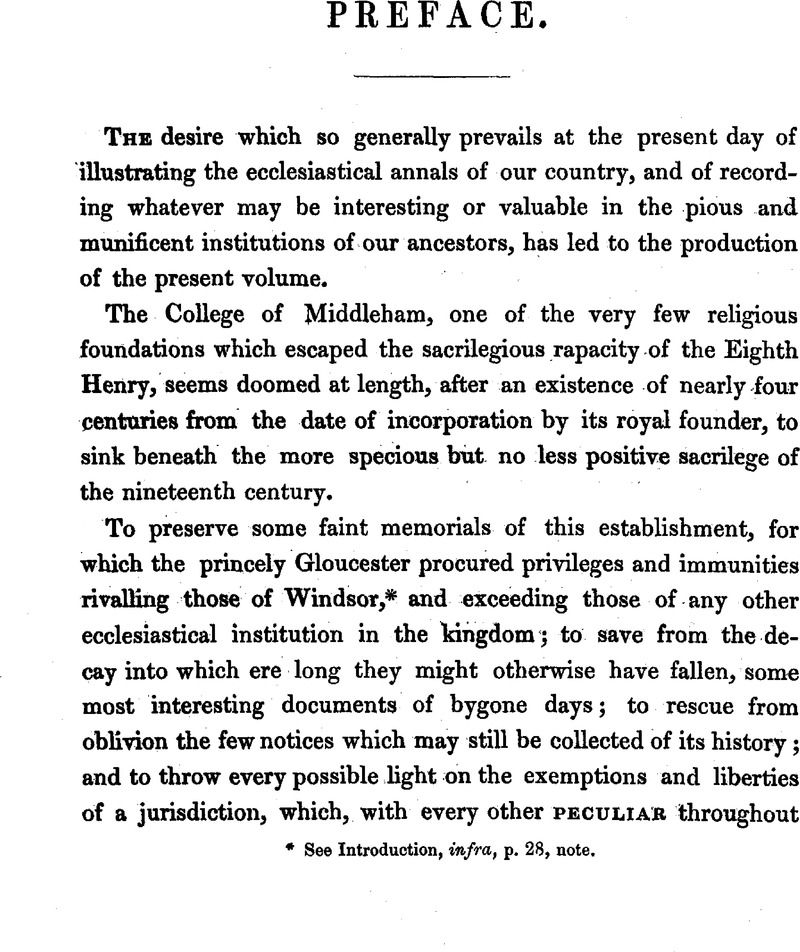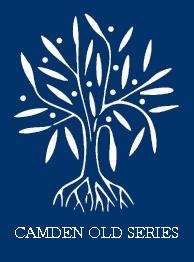No CrossRef data available.
Article contents
Abstract

- Type
- Preface
- Information
- Copyright
- Copyright © Royal Historical Society 1847
References
page vii note * See Introduction, infra, p. 28, note.
page viii note * Sir E. B. Lytton, Bart.
page viii note † Last of the Barons, vol. ii. p. 160.
page ix note * “The land of earl Alan, Medelai (Middleham), to be taxed five carucates, and there may be three ploughs. Ghile Patrick had a manor there ; Ribald now has it, and it is waste. The whole one mile long and one broad, value in king Edward's time twenty shillings.” Bawdwen's (Rev. W.) Translation of Domesday, p. 108.
page ix note † “Robertus hic tempore suo fundavit et ædificavit Castrum de Middelham.” Inter Collectiones Dodsworthii in Bibliotheca Harl. See Gale's Honor of Richmond, Appendix, pp. 233, 234.
page ix note ‡ Whitaker's Richmondshire, vol. i. p. 343.
page ix note § Ibid. p. 332.
page ix note ║ Dugdale's Baronage, vol. i. p. 292.
page x note * “Omnibus hanc cartam indentatam visuris vel audituris Radulphus Comes Westmerlandiæ Dominus de Nevill et Marescallus Angliæ salutem in Domino sempiternam. Sciatis nos quandam cartam indentatam Mariæ de Nevill quondam Dominæ de Midilham, antecessoris nostræ, cuidam Domino Johanni Rectori ecclesiæ de Midilham prædicta et successoribus suis factam, inspexisse in hæc verba. Universis Christi fidelibus ad quorum notitiam præsentes literæ pervenerint, Maria de Nevill Domina de Middilham salutem in Domino sempiternam. Noverit universitas vestra me in pura viduitate ac ligea potestate mea, concessisse et præsenti scripto meo cyrographato confirmasse Domino Johanni Rectori ecclesiæ de Middilham et successoribus suis communiam pasturæ per totum annum ad octo boves et duo jumenta, in bosco meo de Middilham qui vocatur Westwode exceptis clausis meis separabilibus in prædicto bosco existentibus, ubi prædictus Dominus Johannes et successores sui non solebant habere nisi tantum sex boves et duo jumenta : habendum et tenendum prædicto Domino Johanni et successoribus suis prædictam communiam pasturæ ad octo boves et duo jumenta prædicta in prædicto bosco, exceptis duobus clausis in eodem bosco existentibus dummodo permanserint clausa, de me et heredibus meis liberè, quietè, benè et in pace cum pertinentiis suis imperpetuum ; decimis fœni in prædictis duobus clausis prædicto Domino Johanni et successoribus suis in omnibus sibi salvis. Et si contingat quod aliqua averia de prædictis octo bobus et duobus jumentis prædicti Domini Johannis vel successorum suorum, in prædictis duobus clausis pro defectu clausuræ aliquo tempore intraverint et absque wardo facto, sine gravamine et reparatione retractentur. Et prædictus Dominus Johannes pro se et successoribus suis, prædictæ Dominæ Mariæ et hæredibus suis totum jus et clameum communis in prædictis duobus clausis in bosco prædicto dummodo clausa permanserint penitus relaxat. Et quam cito prædicta duo clausa pro non clausis teneantur prædictis Domino Johanne et successoribus suis, ad statum communis pasturæ sex boum et duorum jumentorum prius habitorum revertantur. In cujus rei testimonium præsenti scripto cyrographato alternatim sigilla sua apposuerunt. Hiis testibus, Willelmo de Burgo tunc Ballivo Richemundiæ, et aliis. Datum apud Middilham die Sancti Jacobi Apostoli, anno Domini Millesimo tricentesimo decimo.——Quam quidem cartam ac omnia et singula in eadem carta contenta Ricardo de Pykering nunc Rectori Ecclesiæ de Middilham prædictæ et successoribus suis secundum formam cartæ prædictæ indentatæ, approbamus, confirmamus et ratificamus firmiter per præsentes. In cujus rei testimonium uni parti hujus cartæ indentatæ, penes prædictum Ricardum et successores suos remanenti, sigillum nostrum apposuimus ; alteri vero parti penes nos et hæredes nostros remanenti, dictus Ricardus sigillum suum apposuit. Datum apud Raby vicesimo nono die mensis Decembris, Anno Domini Millesimo, quadringentesimo, quinto et regni regis Henrici quarti post conquestum septimo.”—Middleham MSS.
page xi note * Taxatio Ecclesiastica Angliæ et Walliæ, auctoritate P. Nicholai IV. circa A.D. 1291. London, 1802, folio, p. 307. See also pp. 327, 337.
page xi note † Nonarum Inquisitiones, p. 237. Lond. 1807, folio.
page xi note ‡ Calendarium Inquisitionum post Mortem, vol. ii. p. 282. Lond. 1806, folio.
page xi note § Ibid. vol. iii. p. 103.
page xii note * “Notwithstanding this grant, Ralph Neville never assumed the title of Earl of Richmond.” Nicolas's Synopsis of the Peerage, p. 536, from Third Peerage Report, p. 102.
page xii note † “About the 12th of Ric. II. he obtained the King's charter for a weekly market every Monday at his manor of Middleham, as also a yearly fair at that place at the feast day of St. Alkeld the Virgin, the patron saint of that place.”
page xii note ‡ He lies interred under a stately tomb in the church of Staindrop, adjoining to Raby, in the co. Durham. Whitaker says (i. 345), that “under this earl the power and splendour of the Neviles had attained to a height from which they subsequently declined ;” that “he was the last of the Neviles in the right line who was seised of Middleham and of its dependencies,” and that “henceforth we hear no more of the first line of the Neviles at Middleham.” On this latter point Surtees says (Hist. of Durham, iv. 152), “The Yorkshire castles of Middleham and Sheriff Hutton, and many a dependent manor, and many a fair southern lordship, were settled on the issue of the first earl's second princely alliance.” It must, however, be remembered that the splendour of the second line of Neville, which succeeded to Middleham, greatly surpassed that of the first; and that the grandson of this earl—the inheritor of this castle and its attendant domains—by his union with the heiress of the house of Warwick, elevated the race of Neville to the highest pitch of magnificence and power.
page xii note § Calendarium Inquis. post Mort. vol. iv. p. 206.
page xiii note * See Introd. infra, pp. 1, 4.
page xiii note † “Pro Cantar. Joh'is Chartmele de Midlham.” Middleham MSS. See also Calendarium Rot. Pat. (in Turre Londinensi), p. 315.
page xiii note ‡ “There was a chantry here, at the altar of St. Mary, for the soul of John Cartmell, sometime rector of this church.” Lawton's Collections, vol. ii. p. 568.
page xiii note § Vol. i. p. 341.
page xiii note ║ There can be little doubt that this “one other pryst” here alluded to was the minister for divine services and offices of whom mention will be found in the Introduction, p. 29.

page xv note * Monasticon, vol. vi. p. 781.
page xv note † There were formerly but three bells in the tower. The present excellent peal of six was (A.d. 1824), with all the contingent expenses, the munificent gift to the parish of Middleham of the late John Breare, Esq. of Middleham Hall, now represented by his nephew and successor Christopher Topham, Esq.
page xvi note * Richmondshire, i. 383.
page xvi note † A field at no great distance from the church still bears the name of Foundation Close, where it is said the foundations of the college had actually been laid at the period of Richard's premature decease. “If this were intended for the collegiate building,” remarks Whitaker, i. 338, “and the church were meant to remain where it was, however convenient such an arrangement would hare been for the castle and town, it must have been very incommodious to the dean and canons. Yet there are such instances: the college of Manchester is at a considerable distance from the collegiate church, and that of Kirk-Oswald still farther, but neither so remote as the Foundation Field from the church of Middleham.”
page xvi note ‡ The eastern portion joining the choir is the ancient chantry.
page xvii note * Vol. i. p. 343.
page xviii note * “The belfry chamber has a fire-place, about which are wrought up several fragments of the first church. A fragment of one grave-stone in particular has cut upon it two keys, emblems of the office of some ancient constable of the castle.” Whitaker, Richm. i. 334.
page xix note * See Introd. infra, p. 33.
page xx note * “A huge flat stone, lately removed from the neighbourhood of the pulpit; which is really the tomb of Robert Thornton, 22nd abbat of Jervaulx.” [A.d.1510.] ….. “What account can be given of the removal of so massy a stone, and of its being found in a parish church wholly unconnected with the abbey ? It is certain Thornton had not long been dead at the Dissolution ; and, if he were a native of Middleham, and had friends surviving there, it is not improbable that his remains and his gravestone were removed together on that event to a situation where they might be protected, and where he might thenceforward sleep among his friends.” Whitaker's Richmondshire, i. 334.


